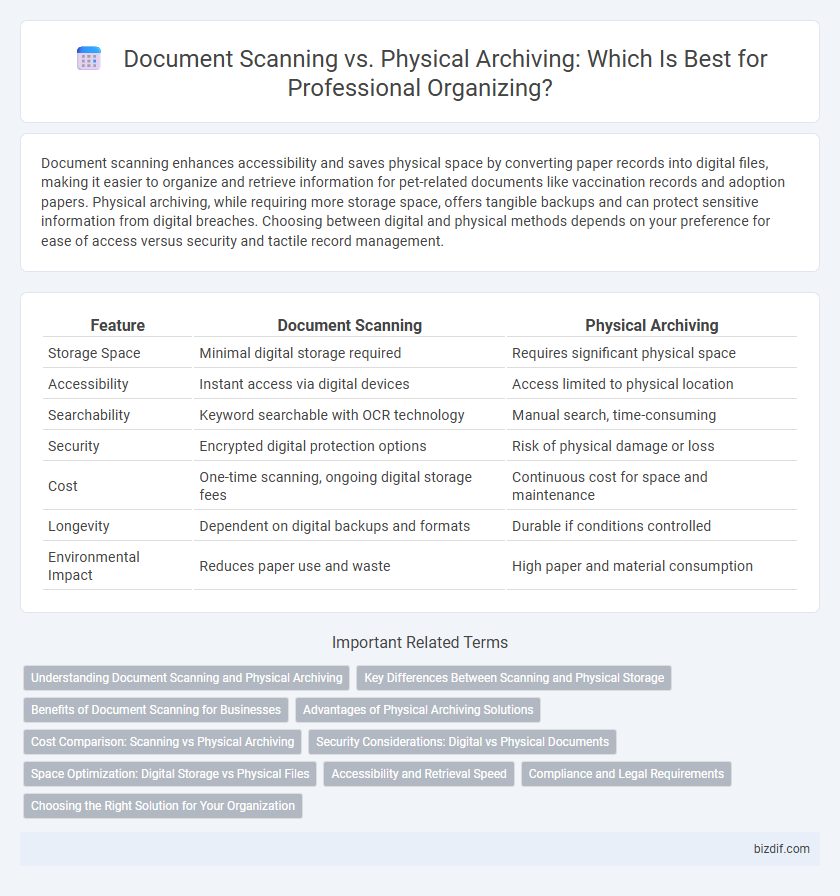Document scanning enhances accessibility and saves physical space by converting paper records into digital files, making it easier to organize and retrieve information for pet-related documents like vaccination records and adoption papers. Physical archiving, while requiring more storage space, offers tangible backups and can protect sensitive information from digital breaches. Choosing between digital and physical methods depends on your preference for ease of access versus security and tactile record management.
Table of Comparison
| Feature | Document Scanning | Physical Archiving |
|---|---|---|
| Storage Space | Minimal digital storage required | Requires significant physical space |
| Accessibility | Instant access via digital devices | Access limited to physical location |
| Searchability | Keyword searchable with OCR technology | Manual search, time-consuming |
| Security | Encrypted digital protection options | Risk of physical damage or loss |
| Cost | One-time scanning, ongoing digital storage fees | Continuous cost for space and maintenance |
| Longevity | Dependent on digital backups and formats | Durable if conditions controlled |
| Environmental Impact | Reduces paper use and waste | High paper and material consumption |
Understanding Document Scanning and Physical Archiving
Document scanning involves converting paper documents into digital files using scanners, enabling easy storage, search, and retrieval while reducing physical clutter. Physical archiving requires organizing and preserving original paper documents in labeled folders and secure filing systems to maintain their integrity and accessibility. Understanding these methods helps determine the best solution for document management based on space, security, and access needs.
Key Differences Between Scanning and Physical Storage
Document scanning converts paper records into digital files, enabling quick search, easy sharing, and space-saving storage in cloud or local servers. Physical archiving requires dedicated space, involves manual retrieval, and risks damage from environmental factors such as fire or moisture. Scanning facilitates efficient document management and backup, while physical storage maintains original paper integrity but demands more resources for organization and security.
Benefits of Document Scanning for Businesses
Document scanning enhances business efficiency by enabling quick digital access to important files, reducing physical storage needs, and optimizing workspace organization. It improves data security through encrypted cloud storage and facilitates disaster recovery with easy backups. Furthermore, digital documents streamline collaboration and compliance with industry regulations by providing searchable, organized records.
Advantages of Physical Archiving Solutions
Physical archiving solutions offer tangible access to documents, reducing dependency on digital devices and potential technical failures. Secure storage options such as fireproof cabinets ensure long-term preservation and protection against environmental hazards. Organizing physical files enhances systematic retrieval and audit compliance, especially in industries with strict regulatory requirements.
Cost Comparison: Scanning vs Physical Archiving
Document scanning reduces long-term storage costs by digitizing files, eliminating the need for physical space and environmental controls required in physical archiving. Initial expenses for high-quality scanners and software may be higher, but digital storage solutions like cloud services offer scalable and cost-efficient data management. Physical archiving incurs ongoing costs for filing cabinets, office space, and preservation materials, often resulting in higher cumulative expenses over time compared to digital document management.
Security Considerations: Digital vs Physical Documents
Digital document scanning offers enhanced security features such as encryption, password protection, and secure cloud storage, which reduce risks of theft, loss, or unauthorized access compared to physical archiving. Physical documents, while immune to cyber threats, remain vulnerable to damage from fire, water, or misplacement and require controlled access environments to ensure confidentiality. Integrating digital scanning with robust backup systems and compliance with data protection regulations optimizes document security and accessibility.
Space Optimization: Digital Storage vs Physical Files
Digital document scanning offers superior space optimization by converting paper files into compact, searchable electronic formats, significantly reducing the need for bulky physical storage. Physical archiving requires considerable space for filing cabinets and boxes, often leading to cluttered environments that hinder accessibility and efficiency. Utilizing digital storage systems streamlines organization, facilitating quick retrieval while maximizing office or home space.
Accessibility and Retrieval Speed
Document scanning significantly enhances accessibility and retrieval speed by enabling instant digital searches and remote access to files from various devices. Physical archiving requires manual searching through folders, which slows down the retrieval process and limits access to a single location. Digital archives also support metadata tagging, improving organization and further accelerating document retrieval compared to traditional filing systems.
Compliance and Legal Requirements
Document scanning enhances compliance by creating secure, searchable digital records that meet legal retention standards and facilitate quick retrieval during audits or litigation. Physical archiving, while traditional, can pose risks due to deterioration, loss, or limited accessibility, potentially complicating adherence to regulations like HIPAA or GDPR. Implementing a hybrid strategy ensures that organizations maintain legally compliant archives while optimizing efficiency and data integrity.
Choosing the Right Solution for Your Organization
Document scanning enhances accessibility, reduces physical storage needs, and facilitates quick retrieval through digital search functions, making it ideal for organizations prioritizing efficiency and space-saving. Physical archiving remains essential for preserving original documents with legal or historical importance, providing tangible backups where digital risks exist. Assessing organizational priorities, compliance requirements, and document usage frequency guides the choice between maintaining physical archives or transitioning to a digital document management system.
Document scanning vs physical archiving Infographic

 bizdif.com
bizdif.com